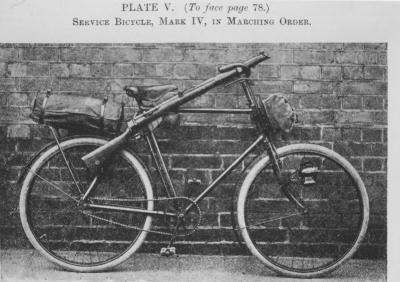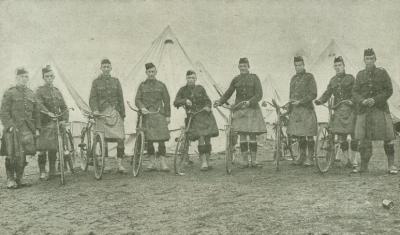Remembrance Day 2019


The advent of the First World War (1914 - 1918) saw many battalions on bicycles rather than horses. Equipped in the same manner as the horse with a bed roll on the front and a rifle slung on its side, the bicycle was used by scouts, messengers, infantry men and even ambulance carriers.

At the outset of the war as the 1st Canadian Division began training at Valcartier, Quebec, it was decided that a cycle unit should be formed to carry out intelligence work with the Canadian Expeditionary Force. So it was that the 1st Canadian Cyclist Company sailed for England with the 1st Canadian Division on October 14 1914. Cyclist companies were also formed with the 2nd, 3rd and 4th Divisions and in May 1916 all four Divisional Cyclist companies were merged into the "Canadian Corps Cyclist Battalion."

Canadian Cyclist Corps. camped on Salisbury Plain 1914
Once in England the cyclists were trained in musketry and bayonet fighting, as well as signaling and topographical techniques. They carried out traffic control, sapping and mining, and served as trench guides, listening posts and battalion runners as well as dispatchers. Despite being hampered by the terrain and muddy conditions, bicycles were used to transport men and supplies over large distances and were said to be able to cover over 60 kms a day.

Allied cyclist scouts walking their bikes in the mud of war-torn France.
With a casualty rate of over twenty per cent, the bicycle corps. became known as a "suicide battalion" or "Gas Pipe Cavalry." One of the hardest hit units was the Newfoundland Regiment ninety per cent of whom were killed or injured at Beaumont - Hamel. Because of their courage, King George V gave the regiment the prefix "Royal" - the only time during the first World War that this honour was given.

The Newfoundland Regiment marching with their bicycles back to billet.
The individual responsible for supplying the Canadian military with bicycles was none other than Tommy Russell, general manager and soon to be president of CCM. Following a meeting on August 14, 1914, with the Minister of Militia and Defense, Colonel Sam Hughes , Russell was made an honourary Major and named purchasing agent for the Canadian Expeditionary Forces.

Demobilization begins as cyclists cross into Cologne.
A Canadian cyclist was the first Allied soldier to cross the Bonn bridge into Germany following the Armistice of November 1918.




